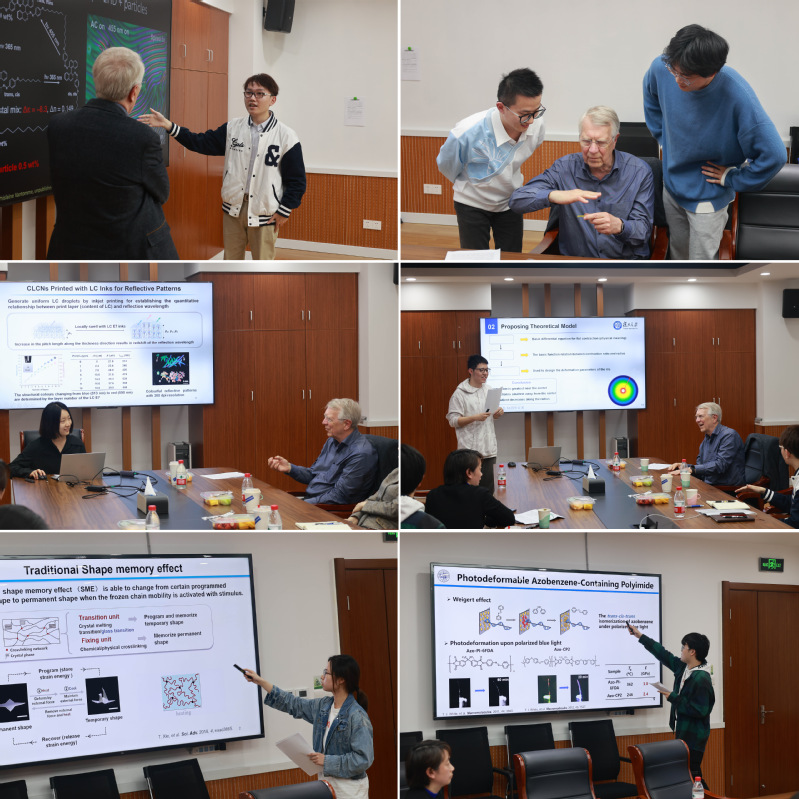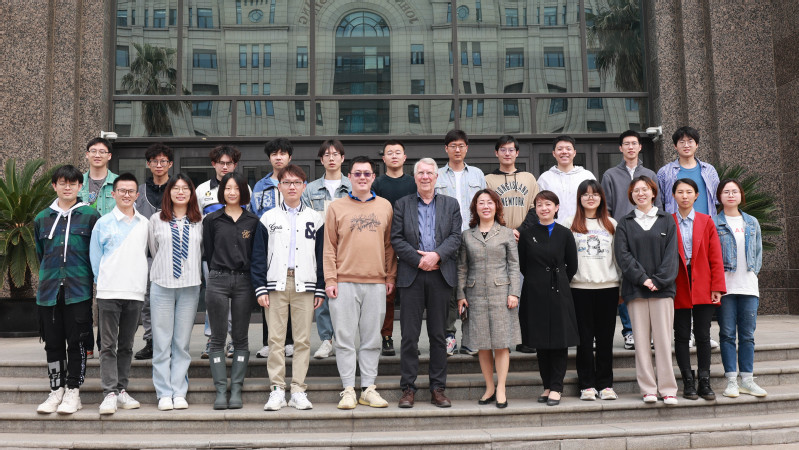Search
On April 14th, 2023, Professor Dirk J. Broer, a member of the Royal Netherlands Academy of Arts and Sciences, former Senior Technical Vice President of Philips, and former head of the Functional Organic Materials and Devices Department at the Eindhoven University of Technology, visited our research group for academic exchange. This was his second visit to our group since April 27th, 2016, after a gap of seven years.
Dirk J. Broer is specialized in liquid crystal polymer networks and self-organized molecular systems. His research follows the complete chain of knowledge from molecule to device. Both top-down and bottom-up methods are employed for the preparation of hierarchically structured materials in the fields of Energy Materials, Stimuli-responsive Materials, and Nanostructured Materials. This entails the development of polymers with new functionalities and integrating them into devices to meet industrial and societal challenges in the fields of sustainable energy, water-management, healthcare & personal comfort. From 2003 to 2010, he was senior research fellow and vice president at the Philips Research Laboratories, specializing on biomedical devices and applications of polymeric materials. He has been a part-time professor at Eindhoven University of Technology (TU/e) since 1996, and was appointed to fulltime professor in 2010, to chair the research group Functional Organic Materials and Devices. Since the same year, he became a member of the Royal Dutch Academy of Arts and Sciences. In 2021, he has received the royal personal decoration 'Knight in the Order of the Lion of the Netherlands', which is the oldest and highest civilian order of chivalry in the Netherlands. To date, Professor Broer has published more than 270 papers, in international peer-reviewed journals including Nature, Nature Materials, Nature Communications, Advanced Materials and others.

In the morning, Professor Broer delivered a report entitled 'Motorized Liquid Crystals Bring Chirality to Perform Work', discussing the principles and applications of intelligent surface wrinkle based on liquid crystals. As a well-controlled self-assembling material, liquid crystals have been widely used in fields such as liquid crystal displays diffractive optics, soft robotics, and active surfaces. Professor Broer’s group introduced chirality to the liquid crystal molecule to self-assemble into a helical structure. Then, they combined these structures with motor molecules that changed conformation or orientation upon activation by an external trigger usually light or electricity. By coordinated interactions within the liquid crystal phases, the liquid crystals self-assemble into dynamic surface wrinkle which was organized around the defect. What’s more, through the principle of free volume expansion under blue light, the amplitude of surface wrinkle was enhanced. In general, professor Broer’s group explained how single-molecule dynamics can be transformed into tangible surface effects, proposing a light-triggered dynamic surface mechanism. Based on this mechanism, they developed various multifunctional devices, including information windows, haptic surfaces, pick-and-place elements, soft robotics, surface effects for lubrication and debris removal and artificial fingerprint skin. During the conference, Professor Broer enthusiastically discussed with the attending teachers and students and patiently answered relevant questions.

In the afternoon, representatives from various research directions in our group also presented their research achievements to Professor Broer through English speeches. PhD student Yao Lu gave a presentation entitled 'Novel Optofluidic Technology Based on Photodeformable Liquid Crystal Polymers', introducing the latest research progress on developing optofluidic technology based on photodeformable liquid crystal polymer materials. PhD student Xiaojun Liu presented 'Decoupled in Situ Geminate Patterns Printed with Chemical and Physical Colours', showcasing a dual-mode label that displays structural and fluorescent color patterns under different light conditions using cholesteric liquid crystal polymer networks. PhD student Feng Pan delivered a report entitled 'Alignment Control of 3D Printing Liquid Crystal Elastomers', where he controlled liquid crystal orientation gradients using 3D printing technology to construct multidimensional deformation liquid crystal elastomer actuators. PhD student Xiaoyu Zhang presented 'Liquid Crystal Polymers with Shape Memory Property', mainly describing how to use shape memory effects to achieve intelligent shaping of light-induced deformation liquid crystal polymers. Master student Menghan Zhang also gave a presentation entitled 'Photodeformable Azobenzene-Containing Polyimide', introducing the latest research progress on expanding the photoisomerization ability of side-chain azobenzene polyimide materials. During the presentations, Professor Broer provided professional comments and expectations for the future of these research directions, drawing on his profound knowledge in the field of liquid crystals.








